Environmental pharmacology
Causes of Environmental Pollution:-
- Toxic gases, Waste water released from industries and houses, Improper dumping of garbage.
- Cutting down of the green cover, Urbanization.
- Pharmaceutical chemicals from industries and hospitals
- The environmental impact of Pharmaceutical products is largely speculative and unmeasured.
- The World Health Organization (WHO) estimates that about a quarter of the diseases facing mankind today occurs due to prolonged exposure to these environmental pollutants
- term ‘Environmental Pharmacology’ was coined by à Halling Sorensen in the year 1998.
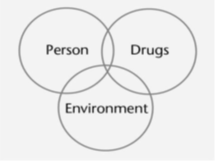
Definition:-
- effect of pharmaceuticals and house care products on the environment and the ecosystem.
- terms Environmental pharmacology, Eco-pharmacology and Pharmacoenvironmentology are often used synonymously
- The increasing human and animal use and abuse of drugs as well as of personal health care and gross domestic products, involve disposal and waste problems and, as a consequence, affect the environmental condition.
Environmental Pharmacology involves study of:-
- 1. Gene-environment interaction.
- 2. Drug-environment interaction.
- 3. Toxin-environment interaction
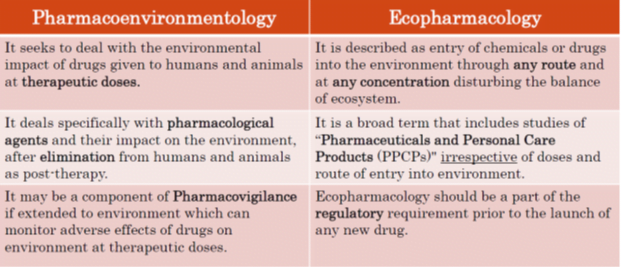
The potential routes of entry of pharmaceutical and house hold care products in the environment include:-
1. Patients’ and animals’ excretion either as a parent compound or metabolites.
2. Direct release from manufacturing, hospitals or disposed via toilets and sinks.
3. Terrestrial depositions via sludge application to land, leaching from solid waste landfills
4. Drugs destined for plant health like insecticides and pesticides.
5. Overflow of agricultural run-off may contain herbicides, pesticides and fertilizers.
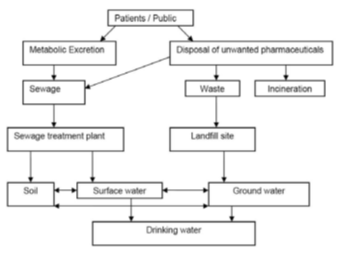

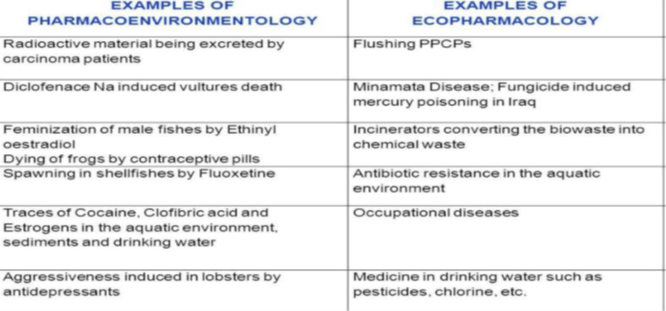
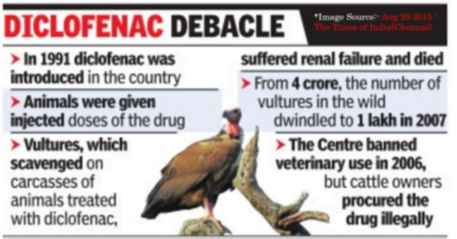
Patancheru, Hyderabad à a deadly cocktail of antibiotic
- Patancheru features a very large number of industries in a limited area.
- A study conducted in 1999 by National Geophysical Research Institute, Hyderabad, documented extensive groundwater pollution and over-exploitation of water resources in Patancheru.
- Ciprofloxacin – As high as 31 mg/L which is approx. 1 million times greater than the levels found in the treated municipal sewage effluents.
- The estimated total release of ciprofloxacin for 1 day was 44 kg, sufficient to treat everyone in a city with 44000 inhabitants.
- Strange cases like a child born without eyeballs, human morbidity, crop declines, and livestock deaths were reported.
PPCPs:- Pharmaceutical and Personal Care Products (PPCPs)
- include collection of substances which refer to any product consumed by individuals for personal health or cosmetic reasons.
- comprises of all human and veterinary drugs (over the counter), diagnostic agents, “nutraceuticals” and other consumer chemicals, such as fragrances, cosmetics and sunscreen agents, “excipients”, biopharmaceuticals, dyes, pesticides, and many others.
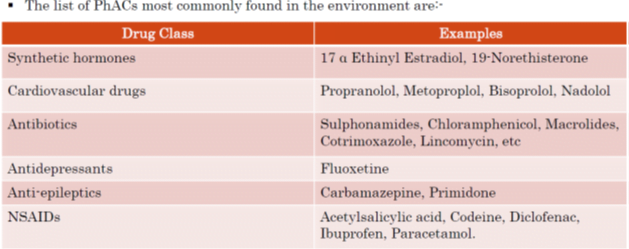
Once PhACs enters the environment, they suffer one of three fates which include:
1. Biodegradation into carbon dioxide and water.
2. Undergo some form of degradation to form metabolites.
3. Persist in the environment unmodified.
Environmentally Persistent Pharmaceutical Pollutants’ (EPPP)-
- compounds that resist biodegradation by the microbes and persist in the environment in active form
- Eg:- Clofibric acid, a metabolite of clofibrate can still be found in surface as well as well water.
- Serious effects of EPPPs on water living organisms and microbial communities have been observed. The diffuse exposure might contribute to:
- I. Extinction of species and imbalance of sensible ecosystems:- Reproductive systems of frogs, fish and mussels.
- II. Genetic, developmental, immune and hormonal health effects to humans.
- III. Development of Antibiotic Resistant microbes, as were found downstream from few sewage plant in India.
Effect on Ecosystem
Drugs interact with the environment in diverse ways causing various modifications and affect:-
Aquatic system
- fish most often share drug targets
- anti- depressants like fluoxetine could trigger spawning in some shell fish.
- masculinization had been observed in female marine snails exposed to tributylin (TBT), a biocide used in antifouling paints.
- Distorted sex-organ development and function in alligators has been linked with a DDT-complex spell into a lake in Florida in USA.
Biofilm layer
- referred to as “slime” are aggregates of microorganisms in matrix of extracellular polymeric substances (EPS) & composed of extra cellular DNA proteins and Polysaccharides
- Medications like anti- diabetics, anti- histamine like diphenylhydramine were observed to cause significant disruption to the biofilm community.
Ground water and surface water
- Indian study, five common non steroidal anti-inflammatory drugs namely diclofenac, ketoprofen, naproxen, ibuprofen and acetylsalicylic acid were detected in various concentrations in surface water from 27 locations of the Kaveri velar and Tami rapani Rivers in southern India.
Effect on Humans
- unavoidable interaction between the different environmental compartments, lets humans to be the direct or indirect target of the pollution.
Autoimmune diseases:-
- Environmental exposure- development and or the exacerbation of autoimmune diseases
- Smoking and the development of seropositive RA.
- UV radiation and the risk of development of multiple sclerosis (MS)
Carcinogens
- chemical compounds that lead to development of cancer on exposure, though chronic.
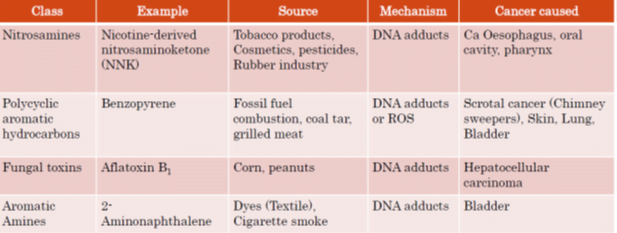
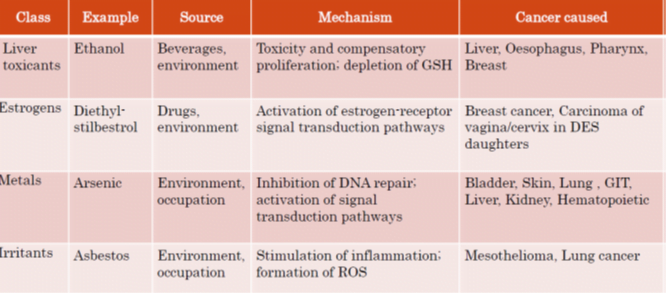
heavy metals that are most commonly implicated in environmental toxicity to humans are:-
- Lead (Pb) à sources à Vehicle batteries, artificial paints, PVC pipes, Statues,
- improper disposal of these products leads to contamination of environment
- Acute toxicity:-Blood levels > 60-80 μg/dl
- Metallic taste, dry throat, abdominal pain, vomiting, sometimes diarrhoea, circulatory collapse, headache, insomnia, renal tubular dysfunction
- Blood lead levels > 80-120 μg/dl- Acute encephalopathy with convulsions, coma, death
- Chronic Toxicity à Facial pallor, Anaemia, basophilic stipling, Bartonian line on gums, Colic & Constipation, Lead palsy- wrist drop, foot drop, CVS, Kidney- HTN, Interstitial nephritis, amenorrhoea, dysmenorrhoea, sterility, abortion
Treatment of lead Poisoning:
Acute poisoning with encephalopathy
- CaEDTA 75 mg/kg/day IV infusion
- BAL (Dimercaprol) 4 mg/kg iv , repeat 4 hrly
For Chronic poisoning
- Succimer (10mg/kg ,p.o.)
Supportive treatment
- Calcium gluconate IV
- Thiamine- neurological manifestations
Mercury (Hg)

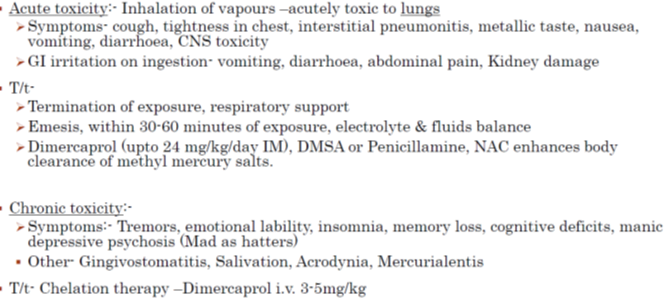
Arsenic (As)
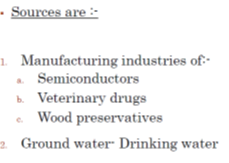
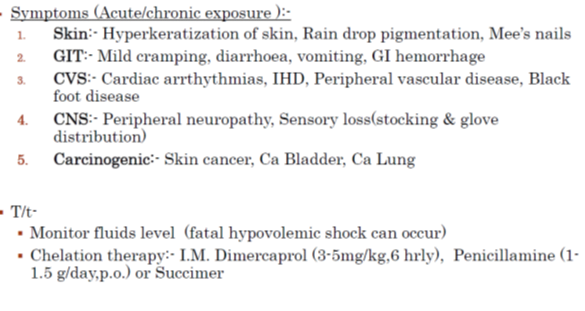
Air pollutant
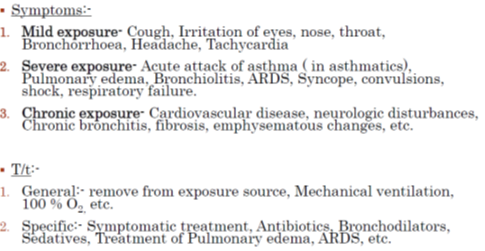
Explain about waste disposal in hospital
Ecopharmacovigilance
World Health Organization (WHO)- “Ecopharmacovigilance is the science and activities
associated with the detection, evaluation, understanding, and prevention of adverse effects
of pharmaceuticals in the environment”.
includes a reference to the pollution of waters and soils with pharmaceutical residues.
